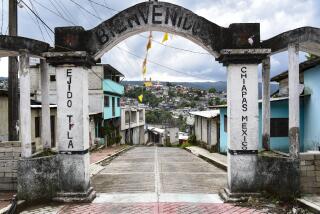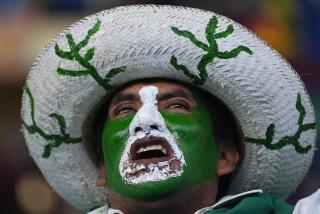Economic Crisis Leaves Poor Hungry, Desperate in Peru
- Share via
LIMA, Peru — It is 6 a.m., a Sunday, still dark and chilly on the coastal desert plain. But food lines are already forming outside bread shops and people’s markets across the Peruvian capital.
A bakery opens in the Pueblo Libre (Free People) district, a treeless swath of older, tidy brick homes owned by teachers and technicians alongside the flimsy grass-and-reed shacks of newly arrived squatters from the Andes highlands. A line forms, the people oblivious to the stench of garbage from the dusty edges of Tomas Valle Avenue.
The middle class and the poor mingle in the line, sharing a reality that over the past six months has taken hold everywhere but in the handful of well-to-do sections of this city of 6.1 million people: More often than not, if you want something in Lima, you have to wait in line for it, if it is available at all.
“The economic crisis is drowning us,” Guillermo Torres Valle, one of the original householders in Pueblo Libre, said after buying a few bread rolls. “We are up to our eyes. These paquetazos (government austerity packages) are killing us.
“In some areas, there are people who eat a bit of bread for breakfast, and again for lunch, and drink water to fill their stomachs.”
Torres Valle watched his sullen neighbors waiting in line and observed: “People are passive, too accepting. But there is going to come a time when things explode. They are going to be sacking the markets.”
Peruvians are no strangers to frustration. Governments have been breaking promises here since the Spanish conquered the ruthlessly efficient Inca empire more than four centuries ago. Public buses are a trial for commuters trying to get home to the slums, and bank transactions can take hours. Patience is not just a virtue but a necessity.
But an economic program gone wrong is indeed straining the traditional resilience of Peruvians, who endured inflation of nearly 2,000% last year. Medical supplies are often unavailable, even for those with money. Strikes by hundreds of thousands of workers turn routine chores into daylong ventures. One of the longest lines is outside the passport office--people who want to flee the country.
Rumors of a coup have eased once again, and President Alan Garcia, his popularity in tatters, maintains that he is on the verge of righting the economy after a spending spree that lasted nearly four years and almost bankrupted the country.
The hardships, his government says, are the necessary result of a series of reforms imposed since September. They include the near-elimination of government subsidies, a move that has more than doubled the price of fuel and some staple foods since September.
The importance of food for the future of democracy in Peru has not escaped the surging Maoist guerrilla movement, Sendero Luminoso, or Shining Path. Earlier this month, the guerrillas exhorted dozens of shantytown residents to carry out an illegal potato harvest on a private farm on the outskirts of Lima--and killed a guard who tried to stop them.
In the meantime, Peruvians of all classes share a pervasive despair--and try to cope.
“Tell your people that we are dying of hunger here,” a young man shouted to a foreign reporter as a food line inched forward in Trebol, an old section in the city’s north. After buying his rice, the man, Andres Villanueva, elaborated: “The people are getting desperate. Communism is growing stronger in these poor areas. It is very dangerous.”
Shortage of Staple
Hundreds of people had gathered at dawn outside the Trebol people’s market, without even knowing whether there would be any rice, a Peruvian staple.
Every Saturday, usually by mid-morning, a government truck arrives at each market and dumps a load of one-kilo bags of rice (2.2 pounds each) at the curb to be sold by municipal workers. On Sundays, the chances that a truck will arrive are only 50-50.
On this Sunday, the people were fortunate. A truck appeared at 10 a.m. and deposited 3,000 bags, enough rice for 600 families. The workers sold each customer up to five bags for 375 intis each (about 25 cents). Schoolteachers are paid about $25 a month.
In Jesus Maria, an older Spanish colonial section of Lima north of the downtown area near decaying Inca ruins, tension infused a rice line that stretched around a block of closed shops.
A day earlier, the supply had run out before half of the people were served, setting off scuffles that came close to being a riot.
Women in the line, their faces taut with anxiety and their eyes hawkishly attentive, kept a lookout for any sign of cheating or cutting in. Several people, many with relatives in the line, formed a semicircle around the pile of rice bags on the sidewalk to monitor the sale.
“Don’t sell five bags, sell four!” one woman shouted. “There isn’t enough!”
The government worker in charge, nervous that the sale would collapse in chaos, vainly pleaded with the people to move back.
Segundo Perez, who works as a technician in a pharmaceutical laboratory, was able to buy his five kilos of rice on his second day of trying.
“When I arrived yesterday at 6 a.m., there were already 600 people in the line,” he said. “At noon the rice ran out, and people were furious.”
Perez, 47, said his family of seven needs 1.5 kilos of rice a day, “so this lasts us three days. Then we have to use pasta or something else for the rest of the week. And pasta is terribly expensive,” the equivalent of nearly $1 a kilo.
Perez earns 90,000 intis a month, the equivalent of about $75, far more than most Peruvians. He takes on odd jobs, such as house painting and welding, in order to get by. In the past six months, he said, “my buying power has fallen 50%. We usually cannot eat meat or chicken or fish. We are up against the wall, with a sword pointed at our bellies.”
Fermin Saladeriaga Arrazabal, who was running the sale, said: “The people finish in line and go to the end to wait again. There is a hoarding mentality, whether there are real shortages or not. And they know that with inflation like it is, they have to spend their money right away or it will be worth less.
“Some of these people buy rice or powdered milk--although we haven’t sold any milk for weeks now--and send their children out to the streets to resell it for twice the official price. And the police do nothing.”
He said there are some markets where people start lining up a day in advance. Lining up, he said, is a way of life.
Attacks by Rebels
At one of the stalls in the adjacent market, a crowd had lined up to buy potatoes, which is another staple and one of the few crops Peru has managed to keep raising in abundance. But landslides in the Andes had cut the main highway to Lima, and people feared there would be a shortage.
The sun grew fierce as noon approached, and the line of customers huddled against a block-long brick wall, trying to stay in the shade.
The shortages are the result of a complex set of problems shared by other Latin American countries. But nowhere are they as acute as in Peru, partly because the guerrilla warfare frustrates what attempts there are at development. A few weeks ago electric power outages were routine because of attacks on power transmission lines. Now the blackouts have stopped.
Food is the sorest point. Rice growers here must sell to the state rice agency, and they complain that they are paid too little and months late. So supplies dwindle. Until recently, currency-exchange rules discouraged exports, so the government’s reserves evaporated. Rice-laden ships wait offshore until there is money to pay for their cargoes. Foreign lenders, unpaid for past debts, refuse to make new loans, so roads and transport deteriorate.
Peasant rice growers in the eastern jungle around Pucallpa went on strike last month because they had been paid too little, or not at all, for their last five months of production. At a protest rally Feb. 9, police opened fire and killed at least 10 farmers.
Peru literally has a shortage of money, too: A lack of paper for the presses that turn out currency has led to a scarcity of small-denomination bills. The lack of change has helped slow rice sales at the markets to a crawl.
Skilled personnel have been leaving the country, and this has caused a personnel shortage that seems sure to worsen. Fearful of guerrilla warfare that has claimed more than 12,000 lives in nine years, and worried about their economic future, an estimated 150,000 Peruvians left the country in 1988--three times the previous year’s total.
To survive, the poorest Peruvians sort through the garbage tossed out by the well-to-do. On a cliff overlooking the Pacific Ocean, a man spent his Sunday picking up scraps of cardboard boxes from a garbage dump near several decaying, abandoned former mansions of the colonial era.
On the beach to the south, below the sand-colored cliffs and the upper-middle-class suburb of Miraflores, the contrast was sharply drawn: Young men dressed in multicolored swimwear joined in a surfing contest as organizers called out the results over a loudspeaker. In the Costa Verde restaurant on the beach, well-off people sipped cocktails under umbrellas and ordered $20 plates of shellfish.
Farther along the coast, in Huacho at the southern edge of Lima, the scene became typical again: more pueblos jovenes , or young towns, home to poor Indians who have migrated here from the mountains in search of a better life.
For those in Huacho, however, even the beach has provided no respite in this Southern Hemisphere summer. Dozens of people, mainly children, have suffered burns in recent weeks from toxic chemicals dumped illegally there. The municipality paid for the funeral of a boy who died from such burns because his family did not have the money.
The cost was the equivalent of $20.
More to Read
Sign up for Essential California
The most important California stories and recommendations in your inbox every morning.
You may occasionally receive promotional content from the Los Angeles Times.










